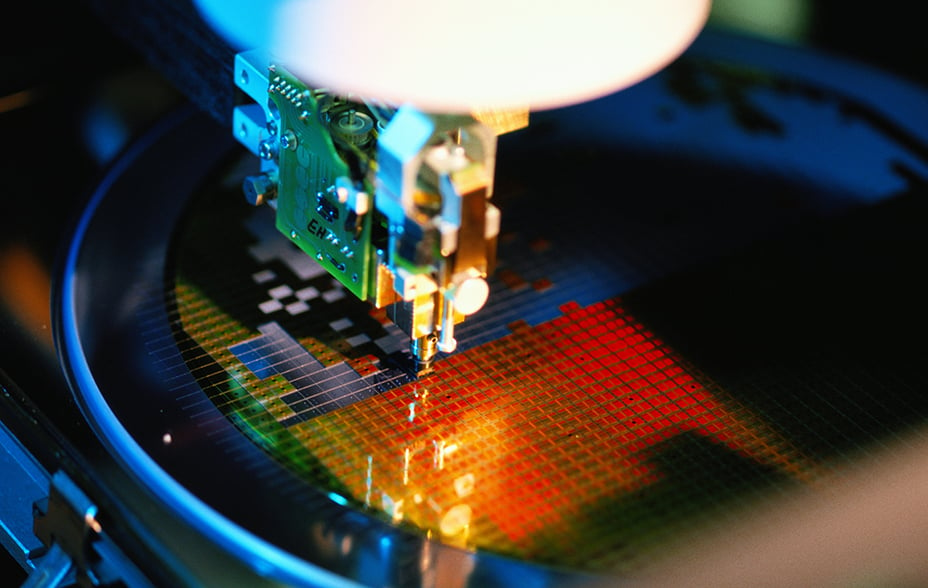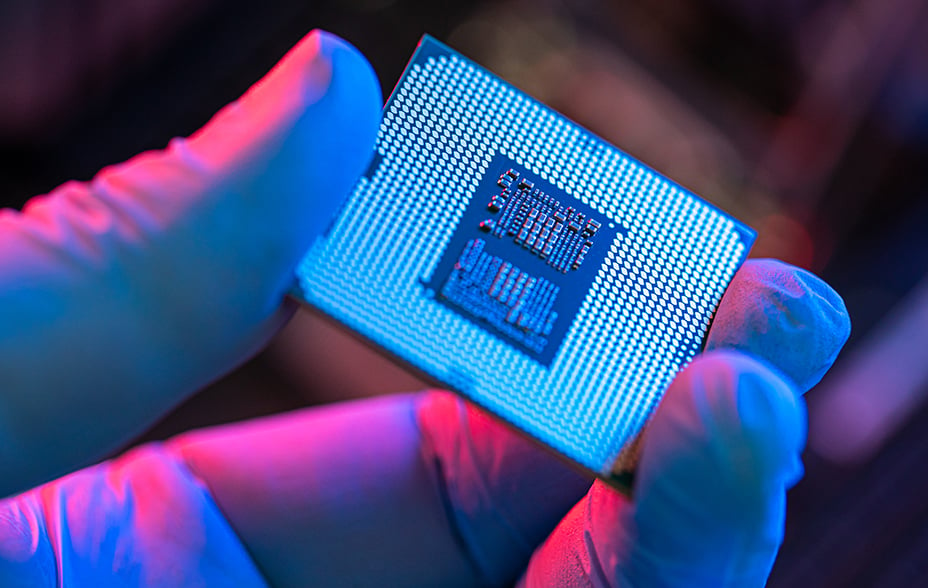
All investment strategies have the potential for profit and loss, capital is at risk. Past performance is not a guide to future returns.
“Most of the world’s GDP is produced with devices that rely on semiconductors. For a product that didn’t exist 75 years ago, this is an extraordinary ascent.”
In 2021, chip makers shipped an incredible 1.15 trillion semiconductors for use across the global economy. That’s the equivalent of more than 36,000 every second of the year. And demand will undoubtedly grow further as the Internet of Things – which involves adding sensors and other digital hardware to everyday objects – increases connectivity, and the explosion of data creates favourable tailwinds for the sector.
Accessing this opportunity, however, is no easy feat. The chip industry has always been plagued by politics, dating back to when it emerged from the Cold War military-industrial complex of the 1960s. It is also highly cyclical, with periods of over- and undersupply. Covid-19 brought much of this to the fore, highlighting how a handful of vulnerable choke points can cause far-reaching disruption.
Where does Japan fit in this dizzyingly complex supply chain?
Japan was once the industry’s epicentre, manufacturing over half of the world’s semiconductors in the 1980s. The ingenuity of Sony’s co-founder Akio Morita, and others, played a large role. They created customised chips for consumer electronics, powering Casio’s calculators, Nintendo’s game consoles and, of course, the Sony Walkman.
Supply chain niches
Although Japan’s dominance has since eroded, it still leads in several fields, including:
- Memory – especially NAND chips, a form of storage that doesn’t need power to hold onto data
- Sensors – Sony has about 50 per cent of the global market
- Power semiconductors – these are used as switches or a means to convert one type of electrical current to another. They feature in everything from toasters to electric-powered tractors
The country also plays a critical role in the broader chip supply chain. It makes more than a third of the specialist equipment used to manufacture semiconductors worldwide. And it provides about half of the raw materials required.
ROHM and Murata are prime examples of Japan’s formidable position in this field.
ROHM manufactures integrated circuits (ICs) and discrete semiconductor devices1. Its edge, however, is in ‘wide-bandgap’ materials2, specifically silicon carbide (SiC) chips – a third-generation substrate3 that brings clear efficiency gains over pure silicon.
We’re beginning to see rapid adoption of this technology because of the enormous miniaturisation advantages it brings to high-power applications, such as electric vehicles.
Murata operates in a highly correlated area of passive components4, notably capacitors, resistors, filters and electromechanical devices. What links these together is the company’s expertise in ceramic materials, its back-end technology and its monozukuri expertise5. These factors enable it to mass produce the parts reliably and to a consistently high standard.
Like ROHM, Murata expects the industry to be buoyed by accelerating demand from automakers and spending on the infrastructure required for 5G data. To meet this demand, Murata has raised its capacity by 10 per cent per annum over the past five years.
Makers of the specialist equipment used to make semiconductors should also reap the benefits. They include Tokyo Electron, JEOL, and DISCO – all three of which are held by Baillie Gifford, the latter two in Japanese Equity funds.
DISCO makes grinding and dicing machines that are used to cut chips in the ‘back-end stages’ of manufacturing. The machines deal with near-finished products that have gone through a costly process, requiring a high level of precision and reliability. These qualities favour the established industry incumbent, in this case, DISCO, which has a dominant 80 per cent market share. Its customer base is fragmented, with no single client accounting for more than 5 per cent of sales. That makes the company more immune than most to the geopolitics at play within the industry.
SoftBank is also a prominent player in semiconductors because of its ownership of Arm. The UK-based chip designer is its crown jewel and single largest position.
Arm was founded in 1990 as a joint venture between Acorn, Apple and VLSI – a company whose founders included a trio from Fairchild Semiconductor6. SoftBank acquired the business in 2016 for $32bn. Arm now has a market-leading, highly penetrated and entrenched position in providing semiconductor architectural design7, used in circa:
- 95 per cent of smartphones
- 63 per cent of Internet of Things devices
- 24 per cent of cars
- 5 per cent of cloud computer servers

In conclusion
Japan remains critical to the global semiconductor ecosystem. Its government is keen to re-energise the chip industry to ensure a stable supply, as evidenced by Prime Minister Fumio Kishida’s attendance at the Tokyo SEMICON exhibition in December. The state is also subsidising a new joint venture, named Rapidus, which includes eight major companies, including Sony, SoftBank and Denso. It aims to deliver next-generation 2-nanometre chip technology8, in addition to a project that involves Taiwanese chip manufacturer TSMC expanding its operations in the Kumamoto prefecture.
Although these actions may help at the margin, our focus remains on the fundamentals of those leading the charge. While others obsess over semiconductor cycles and vulnerability to trade friction crossfire, we will continue to focus on and back businesses well-positioned to capitalise on the more stable drivers of this growth opportunity.
Deeper carve-outs
How could Japan fare if deglobalisation/China rhetoric rises?
Japanese semiconductor production equipment and semiconductor material makers are well placed to benefit in the near-to-medium term from the deglobalisation of the industry’s supply chain and the build-out of new capacity in countries, including at home.
However, Japanese companies risk missing out on longer-term opportunities in China as they get increasingly dragged onto the side of the US in the new technology ‘cold war’. The same is true of Dutch companies, including ASML.
What is the role of 5G?
The Internet of Things and 5G data will create opportunities for the physical world to be more directly integrated into digital systems and spur massive demand for connectivity.
Autonomous driving, for example, will require:
- higher data transmission speeds
- much lower latency – the ‘lag’ between sending data to a remote server and receiving the response
- greater data capacity – the amount of information a network can handle at any point in time
All this will generate unprecedented demand for Murata’s components.
How did Japan lose its lead in semiconductors?
Trade frictions with the US played a role.
In the early 1970s, Japan restricted imports of US-made chips, which Silicon Valley rivals claimed was unfair. Even after the Japanese government dropped its quotas, it continued to subsidise its semiconductor industry. In addition, Japanese firms could raise capital at a lower cost. All this led American firms to perceive they were at a disadvantage, particularly regarding memory chips.
The dynamic encouraged US firms to send orders to and create joint ventures with the Korean chip makers that emerged in the 1980s. It also encouraged them to deal with the Dutch lithography9 specialist ASML rather than Canon and Nikon once GCA, an American competitor, collapsed in 1993.
Other factors that played a role included the rise of the yen against the US dollar in the late 80s and early 90s, which reduced demand for Japan-made consumer electronics, and the failure of Japanese chip producers to adapt to the ‘foundry’ model pioneered by TSMC. This involved the Taiwanese firm manufacturing chips on others’ behalf but not products of its own. This freed its clients of the need to invest in the increasingly expensive equipment required and allowed TSMC to gain huge scale.
What are the three main types of chips?
Memory chips:
These store data and include:
- Dynamic random access memory (DRAM)
- Static random access memory (SRAM)
- NAND memory (the name isn’t an acronym but refers to ‘not and’ logic gates, which its circuitry design resembles)
The memory space is commoditised, very cyclical, and consolidated. Toshiba, NEC and Samsung are key players. When thinking about ‘enabling’ technological advances, it’s fair to say that memory chips are less impactful than other types because the function they fulfil is less demanding.
Logic chips:
A catch-all term for chips that control operations by processing data. They include:
- Commoditised ‘standard’ ICs, which are produced in large volumes for routine tasks
- Programmable chips, including central processing units (CPUs) and graphics processing units (GPUs), which are effectively the brains in most computers
- Application-specific integrated circuits (ASICs), which are customised for use in a specific task and offer resulting efficiency gains. Examples of their use include military hardware and cryptocurrency mining
Analog chips:
While digital chips only distinguish between binary ‘on’ and ‘off’ signals, their analogue counterparts can handle gradations in between. That makes them well-suited to ‘real world’ functions, such as sensing temperatures, speed, sound and electrical currents. Power supply semiconductors – which effectively act as switches, transferring power and converting currents – are also usually analog chips.
1. An integrated circuit is a set of electronic circuits featuring transistors, resistors, capacitors and other tiny components built into a semiconducting material. These are commonly used to carry out different functions and are what people commonly refer to when they talk of a ‘chip’. By contrast, a discrete semiconductor refers to a component that’s only capable of carrying out a single function and is produced as a standalone unit. For example, a special type of transistor or diode. This keeps their price low, making them particularly suited for use in prototypes.
2. Wide-bandgap semiconductors have electronic properties that help devices handle higher radio frequencies, temperatures and voltages than conventional semiconductors. By incorporating them, the electronic components can be more powerful and energy efficient.
3. In this context, substrate refers to the ‘wafer’ that holds together the other elements of a semiconductor device.
4. Passive components can only receive energy. They then dissipate, absorb or store it but cannot amplify or otherwise deliver power to an electric circuit.
5. Monozukuri is a Japanese term that refers to making products with great skill, passion and pride, resulting in excellence and the continued refinement of the process involved. Japanese manufacturers and engineers widely study the concept, but it does not have an exact English translation.
6. Chip pioneer Fairchild Semiconductor built the first complete set of circuits embedded into a single silicon wafer – what’s known as a monolithic integrated circuit – in 1961. It only featured four transistors. But over time, the firm discovered ways to up the count and, importantly, to produce its chips reliably. This ultimately paved the way for the situation today, where chips often feature billions of transistors. The company also secured its legacy by expanding the market for its products beyond defence and space uses to civilian uses. However, the booming market it created led many of its top minds to jump ship to run companies of their own.
7. This includes instruction set architectures, which define how software controls a processor, as well as designs for central processing units (CPUs) and graphics processing units (GPUs), which clients can adapt or use unchanged to make chips. Arm doesn’t build or sell chips of its own.
8. In the past, when semiconductor makers described chips in terms of nanometres, they were referring to the length of their transistor gates – the part that controls conductivity to either let electricity pass through or not. Today, it’s more of a marketing term to distinguish different product generations. But the significance is that as transistors shrink in size, more can be packed into the same space, allowing a chip to become more energy efficient and capable of carrying out faster calculations.
9. Lithography refers to the process used to burn complex patterns of transistor circuitry onto the surface of wafers.
Risk factors
The views expressed should not be considered as advice or a recommendation to buy, sell or hold a particular investment. They reflect opinion and should not be taken as statements of fact nor should any reliance be placed on them when making investment decisions.
This communication was produced and approved in March 2023 and has not been updated subsequently. It represents views held at the time of writing and may not reflect current thinking.
This communication contains information on investments which does not constitute independent research. Accordingly, it is not subject to the protections afforded to independent research, but is classified as advertising under Art 68 of the Financial Services Act (‘FinSA’) and Baillie Gifford and its staff may have dealt in the investments concerned.
All information is sourced from Baillie Gifford & Co and is current unless otherwise stated.
The images used in this communication are for illustrative purposes only.
Important information
Baillie Gifford & Co and Baillie Gifford & Co Limited are authorised and regulated by the Financial Conduct Authority (FCA). Baillie Gifford & Co Limited is an Authorised Corporate Director of OEICs.
Baillie Gifford Overseas Limited provides investment management and advisory services to non-UK Professional/Institutional clients only. Baillie Gifford Overseas Limited is wholly owned by Baillie Gifford & Co. Baillie Gifford & Co and Baillie Gifford Overseas Limited are authorised and regulated by the FCA in the UK.
Persons resident or domiciled outside the UK should consult with their professional advisers as to whether they require any governmental or other consents in order to enable them to invest, and with their tax advisers for advice relevant to their own particular circumstances.
Financial intermediaries
This communication is suitable for use of financial intermediaries. Financial intermediaries are solely responsible for any further distribution and Baillie Gifford takes no responsibility for the reliance on this document by any other person who did not receive this document directly from Baillie Gifford.
Europe
Baillie Gifford Investment Management (Europe) Limited provides investment management and advisory services to European (excluding UK) clients. It was incorporated in Ireland in May 2018. Baillie Gifford Investment Management (Europe) Limited is authorised by the Central Bank of Ireland as an AIFM under the AIFM Regulations and as a UCITS management company under the UCITS Regulation. Baillie Gifford Investment Management (Europe) Limited is also authorised in accordance with Regulation 7 of the AIFM Regulations, to provide management of portfolios of investments, including Individual Portfolio Management (‘IPM’) and Non-Core Services. Baillie Gifford Investment Management (Europe) Limited has been appointed as UCITS management company to the following UCITS umbrella company; Baillie Gifford Worldwide Funds plc. Through passporting it has established Baillie Gifford Investment Management (Europe) Limited (Frankfurt Branch) to market its investment management and advisory services and distribute Baillie Gifford Worldwide Funds plc in Germany. Similarly, it has established Baillie Gifford Investment Management (Europe) Limited (Amsterdam Branch) to market its investment management and advisory services and distribute Baillie Gifford Worldwide Funds plc in The Netherlands. Baillie Gifford Investment Management (Europe) Limited also has a representative office in Zurich, Switzerland pursuant to Art. 58 of the Federal Act on Financial Institutions (‘FinIA’). The representative office is authorised by the Swiss Financial Market Supervisory Authority (FINMA). The representative office does not constitute a branch and therefore does not have authority to commit Baillie Gifford Investment Management (Europe) Limited. Baillie Gifford Investment Management (Europe) Limited is a wholly owned subsidiary of Baillie Gifford Overseas Limited, which is wholly owned by Baillie Gifford & Co. Baillie Gifford Overseas Limited and Baillie Gifford & Co are authorised and regulated in the UK by the Financial Conduct Authority.
Hong Kong
Baillie Gifford Asia (Hong Kong) Limited 柏基亞洲(⾹港)有限公司 is wholly owned by Baillie Gifford Overseas Limited and holds a Type 1 and a Type 2 license from the Securities & Futures Commission of Hong Kong to market and distribute Baillie Gifford’s range of collective investment schemes to professional investors in Hong Kong. Baillie Gifford Asia (Hong Kong) Limited 柏基亞洲(⾹港)有限公司 can be contacted at Suites 2713–2715, Two International Finance Centre, 8 Finance Street, Central, Hong Kong. Telephone +852 3756 5700.
South Korea
Baillie Gifford Overseas Limited is licensed with the Financial Services Commission in South Korea as a cross border Discretionary Investment Manager and Non-discretionary Investment Adviser.
Japan
Mitsubishi UFJ Baillie Gifford Asset Management Limited (‘MUBGAM’) is a joint venture company between Mitsubishi UFJ Trust & Banking Corporation and Baillie Gifford Overseas Limited. MUBGAM is authorised and regulated by the Financial Conduct Authority.
Australia
Baillie Gifford Overseas Limited (ARBN 118 567 178) is registered as a foreign company under the Corporations Act 2001 (Cth) and holds Foreign Australian Financial Services Licence No 528911. This material is provided to you on the basis that you are a ‘wholesale client’ within the meaning of section 761G of the Corporations Act 2001 (Cth) (‘Corporations Act’). Please advise Baillie Gifford Overseas Limited immediately if you are not a wholesale client. In no circumstances may this material be made available to a ‘retail client’ within the meaning of section 761G of the Corporations Act.
This material contains general information only. It does not take into account any person’s objectives, financial situation or needs.
South Africa
Baillie Gifford Overseas Limited is registered as a Foreign Financial Services Provider with the Financial Sector Conduct Authority in South Africa.
North America
Baillie Gifford International LLC is wholly owned by Baillie Gifford Overseas Limited; it was formed in Delaware in 2005 and is registered with the SEC. It is the legal entity through which Baillie Gifford Overseas Limited provides client service and marketing functions in North America. Baillie Gifford Overseas Limited is registered with the SEC in the United States of America.
The Manager is not resident in Canada, its head office and principal place of business is in Edinburgh, Scotland. Baillie Gifford Overseas Limited is regulated in Canada as a portfolio manager and exempt market dealer with the Ontario Securities Commission ('OSC'). Its portfolio manager licence is currently passported into Alberta, Quebec, Saskatchewan, Manitoba and Newfoundland & Labrador whereas the exempt market dealer licence is passported across all Canadian provinces and territories. Baillie Gifford International LLC is regulated by the OSC as an exempt market and its licence is passported across all Canadian provinces and territories. Baillie Gifford Investment Management (Europe) Limited (‘BGE’) relies on the International Investment Fund Manager Exemption in the provinces of Ontario and Quebec.
Israel
Baillie Gifford Overseas is not licensed under Israel’s Regulation of Investment Advising, Investment Marketing and Portfolio Management Law, 5755–1995 (the Advice Law) and does not carry insurance pursuant to the Advice Law. This material is only intended for those categories of Israeli residents who are qualified clients listed on the First Addendum to the Advice Law.
Ref: 36284 10018752









